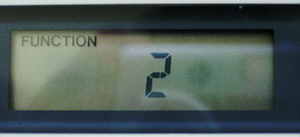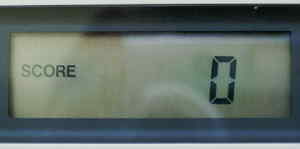 |
|
polyphonic
squarewave mini- keyboard with audiogames |
This keyboard is almost identical with the Yamaha
HS-200, but like Bontempi HT
313.10 it features additional "music games" to teach note and chord
recognition, melody play etc. using an LCD display.

different main features:
-
5 built-in audiogames with each 3 levels
-
LCD display to indicate note letters and game scores
-
multi-chip hardware:
-
sound CPU= "Yamaha YM-1018B, 24 07 21" (GH-2 | 24 pin DIL)
-
game CPU= "IG06070, E2210K-208" (64 pin SMD)
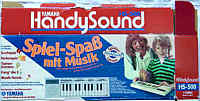 (I strongly retouched this photo, because my original box
is very bleached out.)
(I strongly retouched this photo, because my original box
is very bleached out.) |
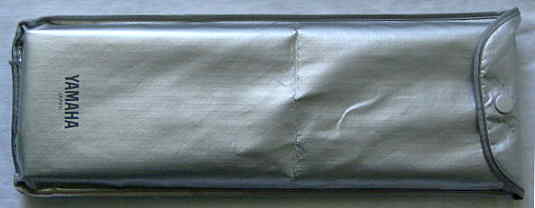
 |
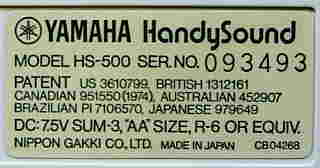 |
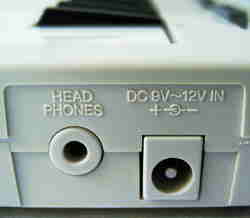 |
eastereggs:
test mode: Press "function" + "start" during power-on to start the LCD
segment test, which shows a pattern of 2 alternating combinations (flashing
through 4 phases) on the display. The keyboard works like normal during
this.
notes:
Unlike with Casio, the use of an LCD was extremely unusual in early
Yamaha
keyboards. Unfortunately Yamaha missed the chance of building a polyphonic
Casio
VL-Tone competitor, thus despite LCD it features neither a synthesizer
nor rhythm nor sequencer, but only the audiogames. At least the games include
also fairly hard exercises and not just trivial monophonic stuff like found
in certain cheap modern toy keyboards from China.
The audiogames include various polyphonic sound effects and jingles
played in the current main voice preset sound. At the end of each game
(usually after time runs out) the game score is displayed to indicate how
well the player played. The games are selected with the 'function' button,
the level with 'level'. To begin press 'start'. I have downloaded the manual
from Yamaha; it contains
various additional pen and paper learning games to recognize note sequences,
however it does not seem to be complete; e.g. game 6 and higher levels
are not mentioned at all in that manual. The games also don't have names
in it, thus they were named by me.
function 1: keyboard play
Normal keyboard play mode; the last played note letter is indicated
on the LCD. Strange is that also here the 'level' button cycles through
'1'..'3' despite these and the 'start' button seem to change nothing in
this mode.
-
function 2: play displayed notes
The instrument displays note letters and the player has to play the
corresponding notes before the next note comes. When played well, the instrument
plays a fanfare. Each note scores 5 points. Game time is 60 seconds. Score
up to 45 = poor, 50..80 = good, over 90 = very good (fanfare).
levels:
-
= play 1 note (monophonic)
-
= play 2 notes together
-
= play 3 notes together
-
function 3: play heard notes
The instrument slowly plays notes (one per second). The player has
to hit the corresponding key in time. Correct hits play a glissando sound.
Game time is 80 seconds. Score up to 45 = poor, 50..80 = good, 90..100
= very good (fanfare).
levels:
-
= instrument repeats note until correct key is hit.
-
= instrument plays ascending and descending tone scales (only naturals).
-
= instrument plays ascending and descending notes including sharps.
-
function 4: repeat the note sequence
The instrument slowly plays a monophonic 7 note sequence. The player
has to repeat that sequence with correct note length. Leading wrong notes
are ignored. Score up to 25 = poor, 30..40 = try not to play too fast or
too slow, 50..65 = try to play each note the same length, 70..85 = fairly
good, 90..100 = very good (fanfare).
levels:
-
= sequence is made from 3 adjacent note pitches (only naturals).
-
= sequence is made from 4 adjacent note pitches (only naturals).
-
= sequence is made from any notes within an octave.
-
function 5: repeat the chord
The instrument plays a 3 note chord. The player has to repeat that
chord on the keyboard. When he plays wrong 2 times , the correct note letters
are displayed. Until you reach 30 points, the instrument plays only 3 different
chords (C, F, G); the 3 notes play separately before the chord sounds.
After 30 points only the chord sounds. Score = 5 points per chord question;
2 points when you answer correctly the 2nd try. (20 chord questions in
total => perfect score = 100). After 50 and 70 points the instrument each
uses 3 additional chords
levels:
-
= only naturals
-
= with sharps
-
= like 2 (but more different chord types?)
This is a 2 player game in the tradition of Pong. But instead
of seeing a tennis ball, you only hear its position as a glissando. The
1st player serves the ball by pressing the lowest F key. Then a line of
ascending notes sounds to indicate the ball position. The 2nd player has
to press the corresponding key on the right keyboard halve to return the
ball (which makes the note line descend again). When he misses the ball,
he has to serve the next ball with the high E key. Wrong key presses take
no effect. They play notes only while the ball is not flying. Remember,
this is an audiogame, not a videogame, thus the LCD only displays the score
(like "1-3").
levels:
-
= slow, only natural keys
-
= faster, natural & sharp keys
-
= like 2, but only one try to hit a flying ball (i.e. any previous wrong
key press misses the ball).
hardware details
The Yamaha HS-500 is built around the sound CPU "Yamaha YM-1018B" (GH-2,
crystal clocked @ 343.4 kHz) that communicates with the game CPU "IG06070"
(crystal clocked @ 32.768 kHz) which controls the LCD.
The hardware differs from Yamaha HS-200.
It employs an additional CPU for game and LCD control (SMD, gladly labelled
"microcomputer" on the PCB) that is labelled "IG06070", but is referred
in Yamaha HS-200/ HS-500 service manual as "uPD7503G", which naming hints
that it may be made by NEC. The sound CPU is slightly bigger than the YM-10080
of HS-200 but still polls keys and sound switches by itself.
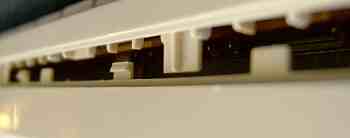 While
opening the case, be careful not to crack off these plastic tabs at the
front rim. While
opening the case, be careful not to crack off these plastic tabs at the
front rim. |
The concept of a keyboard with audiogames is described in the US patents
4781099 (musical quiz = chord training) and 4453439 (audio tennis, with
hardware details). They seem to be defined rather by logic gates than software. |
A very similar keyboard with yellow case and different audiogames (shows
musical notes on the LCD) was released as Yamaha
HS-501. A HS-500 variant without games (nor LCD) was the Yamaha
HS-200.
| removal
of these screws voids warranty... |
|
|
 |

|
|
| |
back
|
|
 (I strongly retouched this photo, because my original box
is very bleached out.)
(I strongly retouched this photo, because my original box
is very bleached out.)



